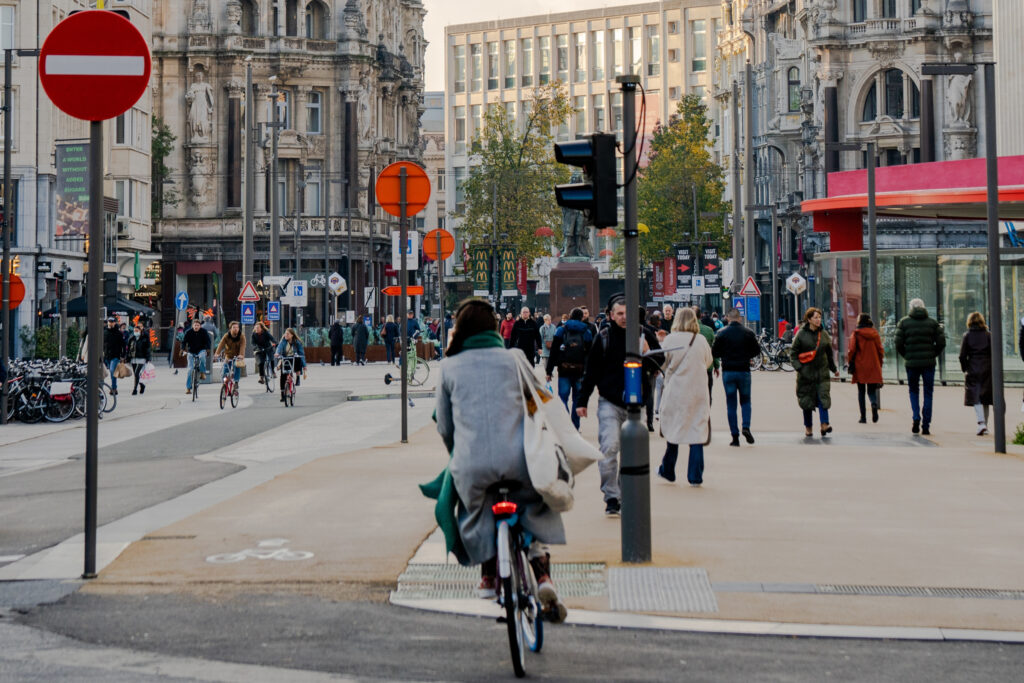This website uses cookies so that we can provide you with the best user experience possible. Cookie information is stored in your browser and performs functions such as recognising you when you return to our website and helping our team to understand which sections of the website you find most interesting and useful.
Antwerp – a good Low Emission Zone is a well-prepared one

What distinguishes the Low Emission Zone in Antwerp? Not its size or the severity of the regulations, but how carefully it was prepared. A lot of time and effort was devoted to informing the residents about the changes that awaited them – years before the start of the Zone. Antwerp is a good example of how to implement LEZs in a way that respects those who will live there.
Antwerp started planning a Low Emission Zone more than a decade ago, in 2012, when preparatory studies measuring the level of the most toxic nitrogen dioxide and the amount of soot in the air of this Belgian city began. These studies not only served as the basis of the decision to introduce a LEZ which was made a year later, but were later used to assess the effects of its operation.
Talk to inhabitants first, introduce later
However, the decision to create a LEZ in Antwerp made in 2013 did not result in the immediate implementation of this idea. In 2014, residents were officially informed of the intention to establish a Zone, and the first phase of LEZ was not introduced until three years later. Why did the city authorities opt for such a seemingly slow process? The reasons were as follows:
• willingness and need to prepare an appropriate educational campaign,
• providing residents with time to prepare for the upcoming changes,
• launching monitoring systems and databases for the ongoing operation and control of the Zone.
The educational campaign aimed to make the inhabitants of Antwerp aware of the threat of pollution emitted by cars and of the means of fighting them effectively. At the same time, constant reminders about the changes awaiting in the coming years increased the chances that no one would miss them or forget about them – therefore, everyone would be able to prepare for them in accordance with the requirements and their person capabilities. Interestingly, in later years, after the launch of the LEZ, subsequent stages of tightening the regulations were planned, also at intervals of several years – precisely to give people the time necessary for planning and implementing life and business decisions related to the Zone. (e.g. car leasing, location of their company’s headquarters).
The campaign was carried out using all available channels and tools to reach the largest possible audience – by means of posters, brochures, films, articles, as well as in direct contact with garage owners and employees of vehicle inspection stations. It was carried out everywhere – on the Internet and in traditional media, and, of course, in the city – in hotels, tourist information offices, embassies, etc. The information had to reach both those who lived in Antwerp and those who ran business there or were just visiting. Communication was open and based on honest dialogue, which helped raise the level of public approval for the Low Emission Zone.

LEZ in Antwerp in numbers
The Antwerp zone covers only 10 percent of the city area – 20 square kilometers in the very center. Despite this, its area has as many as 200 000 of the over 500 000 residents. Its boundaries were determined by the fact that public transport in this area is dense and effective, which minimizes the impact of restrictions on the comfort of movement. In addition, outside the Zone, there are P+R car parks for people coming from outside the city, equipped with charging stations and places for bicycles.
The second significant characteristic of this Zone is that the control of compliance with its regulations is total, not random! It is carried out via the monitoring system built in the preparation phase, based on cameras that read the license plates of all cars entering the Zone. After eight days of “rest”, records from the cameras are directed to an automatic system that finds each vehicle in the database and checks whether it is allowed to enter the LEZ. The database contains the data of vehicles registered in the Netherlands and Belgium. Visitors from other countries must register in the database before entering the Antwerp zone, but the process is simple – it can be done via a phone app. The aforementioned 8 days of waiting before the control are intended for processing the records by the system.
When it comes to vehicles that do not have the right to enter the Zone, the situation is different – the database of one-off, paid passes is also checked. If a given car is not in it, a fine is inevitable.
Zone and punishment
Unauthorized entry to the Low Emission Zone in Antwerp will leave your wallet 150 euros lighter – but only if you break the restriction for the first time. A repeat offence within 12 months will set you back 250 euro, while the third and each subsequent illegal entry results in a fine of as much as 350 euro! To make sure that the fine is merited, each ticket is checked against the results from the database.
So, who can enter the Antwerp LEZ? Currently, from January 2020, electric cars, hydrogen cars and plug-in hybrids with CO2 emissions up to 50 g/km, military vehicles, emergency services vehicles, Euro 2 to 6 petrol combustion or LPG vehicles that meet the standards, as well as and Euro 5 to 6d diesels, are allowed to enter it without any restrictions. After purchasing a temporary permit (from one week to one month, four months or a year), Euro 4 diesels can also enter the Zone. Other cars must purchase a relatively expensive day pass for 35 euro, which can only be purchased eight times a year.
The emissions bar will be raised in Antwerp on February 1st 2025 – from this day onwards, Euro 2 standard petrol and LPG cars, as well as Euro 5 diesel cars will be prohibited from entering the Zone and only Euro 6d vehicles will be allowed in it.
(photos: Thomas Konings on Unsplash and Aron Marinelli on Unsplash)
